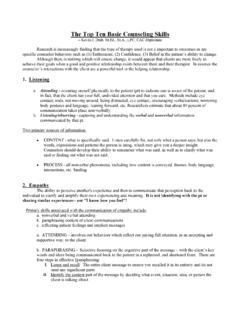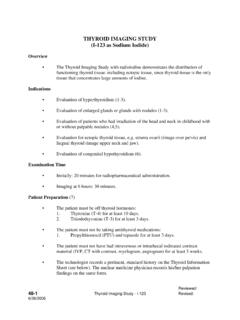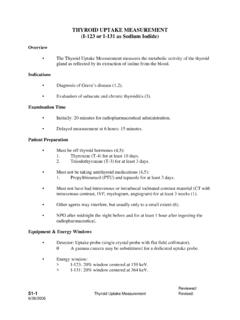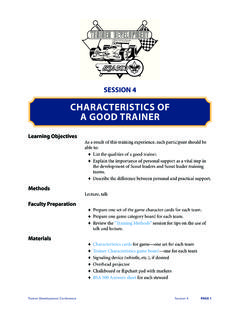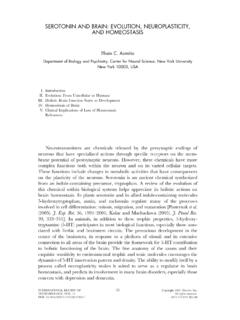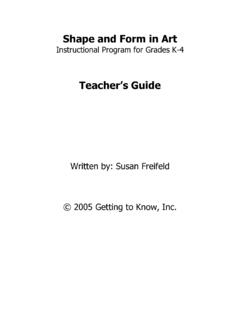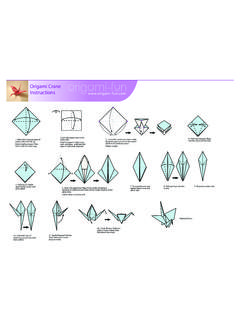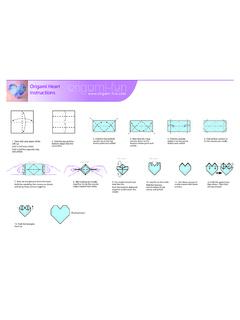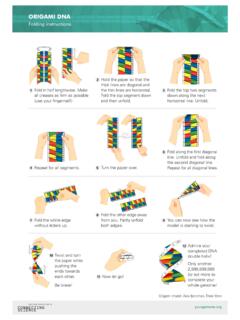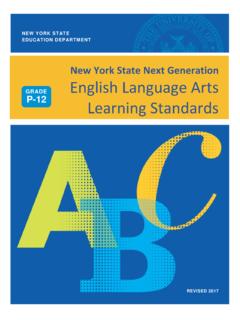Transcription of TRAINING METHODS - Virginia Commonwealth University
1 Learning ObjectivesAs a result of this TRAINING experience, each participant should beable to: Describe several METHODS to effectively train leaders. Demonstrate the use of several effective TRAINING METHODS . Explain the pros and cons of each TRAINING method. Explain why the use of different METHODS is important to be asuccessful , demonstrationFaculty Preparation This session is best taught by two trainers who can take turnsexplaining the TRAINING METHODS . By having two trainers, eachhas the time to prepare materials for a fast can clearly see the differences between the variousmethods being presented. Be aware of your room arrangement. Plan the movement ofparticipants in ways to minimize disruption and the loss oftime.
2 Practice making the flapping bird. Instructions are below. Know which METHODS are being used in each session and relatethe METHODS to the discussions in this session. Review the TRAINING Technology session handouts for tips onusing METHODST rainer Development ConferenceSession 8 PAGE 1 SESSION 8 Note:Whenever possible, tie the METHODS used in the other train-ing sessions to the appropriate section in this Instructions for flapping bird Case studies(one set for each team) Props for role playing on the basis of the case study Overhead projector and screen Flipchart and markers Flipchart paper, cut down to be in squares, for presenter todemonstrate making the origami bird BSA 500 Answers sheetfor each stewardOverheadBSA 500 QuestionsHandouts origami paper or square sheets of paper cut from 81 2 11 sheets of paper Rules for Discussion Leaders Summary of TRAINING METHODS Time60 minutesPizzazzUse a song, stunt, run-on, or other morale feature to lead into or paraphrase,An effective trainer is one who creates, seeks, and finds opportuni-ties for learning.
3 However, not all trainers and not even all effectivetrainers, use the same TRAINING METHODS to create learning opportu-nities. Each of us is particularly adept at one or two trainingstyles/ METHODS . We base the METHODS we use on our own learningstyles and the environment in which we were can (and should) be presented in any number of best way for one group of learners may not be the best foranother. Additionally, what is best for one learner in a group maynot be the best for another learner in the same group. Thus, to bean effective trainer, you need to know what will best reach thelearners in the present group. You also need to be familiar with avariety of TRAINING METHODS and how to use each effectively.
4 Finally,Trainer Development ConferenceSession 8 PAGE 2an effective trainer uses a variety of METHODS within a single train-ing session because that helps everyone learn purpose of this session is to familiarize trainers with the trainingmethods available, and when each method can be used most effec-tively. We also note some of the advantages and drawbacks of usingeach with an overhead transparency or flipchart on which each ofthe TRAINING METHODS is written. Construct the flipchart or trans-parency in such a way to enable you to reveal one method at a the session on TRAINING Technologyfor hints on making aneffective transparency or session will cover these TRAINING METHODS :Some of the TRAINING METHODS are only discussed.
5 Participants willpractice others. Follow the guidelines in each section for your discussion on lecture with an example. Say,To get us started, I have invited [other staff member sname] to teach us about [topic].Quickly introduce the other presenter and turn the presentationover to him or her. The staff member should then give a preparedand rehearsed two-minute lecture on a topic of his or her it formal. Do not allow interruptions or the staff member and then say:Everyone has experienced lectures before, either inschool, at work, or in the community. Some were posi-tive experiences; others were these points about lectures:What Is a Lecture?When one person conveys information to a group of learners bytalking to them, with or without the use of visual aids.
6 There is noparticipation by the learners and consequently there is little or nofeedback to the l kDemonstrationDiscussionCase studyRole playingSimulationBrainstormingBuzz groupsQuestion and answer sessionsLearning centersReflectionTrainer Development ConferenceSession 8 PAGE 3 When to Use a Lecture In large groups where discussion involving the learners is notpractical. When topics are new to the learners, and they have no relevantpersonal experiences. When the speaker is a recognized expert in the field, and peo-ple are coming to hear what he or she has to the participants to describe or list the advantages and drawbacksto the lecture method of presentation.
7 List the answers on an over-head transparency or flipchart. Use the points listed below as a of a Lecture The same information may be shared in a time-efficient man-ner with a large number of people. The information is not altered or sidetracked by commentsfrom those in attendance. Expert information is of a Lecture To be sure learning occurs, question or discussion periodsshould be used to follow up. Visuals are necessary to make this TRAINING method workable.(Refer back to the session: How Adults Learn .) Even withvisuals, the overall depth of learning and remembering will below. However, a lecture is the preferred method of learning forsome adults.
8 Success is contingent on the presenter s knowledge and are making a talk in this session. You are imparting knowledge,but you are also allowing the learners to help find the answers. Besure to make this point to the group. Then ask them to briefly namethe advantages and disadvantages of the informal talk trainingmethod. List the answers on an overhead transparency or these first two points and then use those listed below them asa guide for Is a Talk?A talk is similar to a lecture, except learners are more feedback is obtained through questions, answers, or brief to Use a Talk When the information is less technical or familiar to the learn-ers. The material is still relatively new to them, but they mayhave some experiences relevant to the Development ConferenceSession 8 PAGE 4 When time is available to allow discussion or questions fromthe learners.
9 For most purposes in Scouting (rather than a lecture).Advantages of a Talk A talk is less formal and more comfortable for everyone. A talk usually involves a smaller amount of material than a lec-ture. A talk allows learners to ask relevant questions and be moreinvolved in the learning of a Talk The leader must be well-versed in the subject matter, and will-ing and able to answer questions. A talk cannot be a cannedpresentation. Learners may interrupt the presentation of material with aquestion which is not relevant. The presenter must know howto deal with interruptions effectively to keep the presentationon the discussion of a demonstration by giving each participant asquare sheet of paper.
10 Using the origami Bird directions, carefullydemonstrate how to make a simple origami bird, using a largersquare of flipchart paper. Be sure to do the demonstration where allthe participants can easily see what you are doing. It is also helpful ifyour sheet of paper has color on one side and is white on the each participant in achieving the goal. Have the staff mem-bers help you if the group is large. Following successful completion,reveal the word demonstrationon your flipchart or overhead trans-parency and discuss this TRAINING an alternative demonstration familiar to you is also accept-able. But be sure your demonstration is something new to themajority of your learners.
